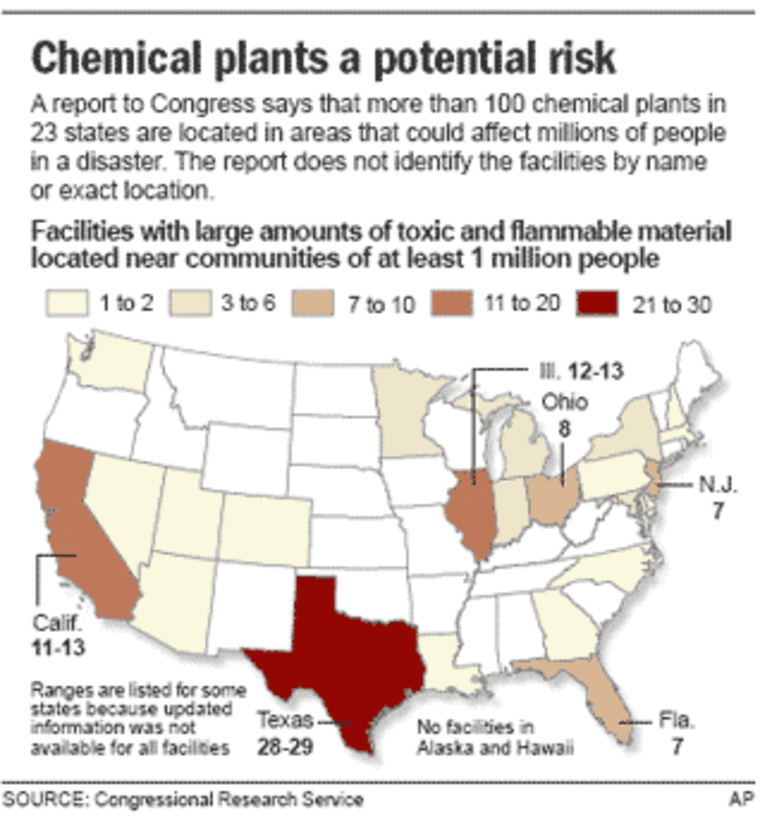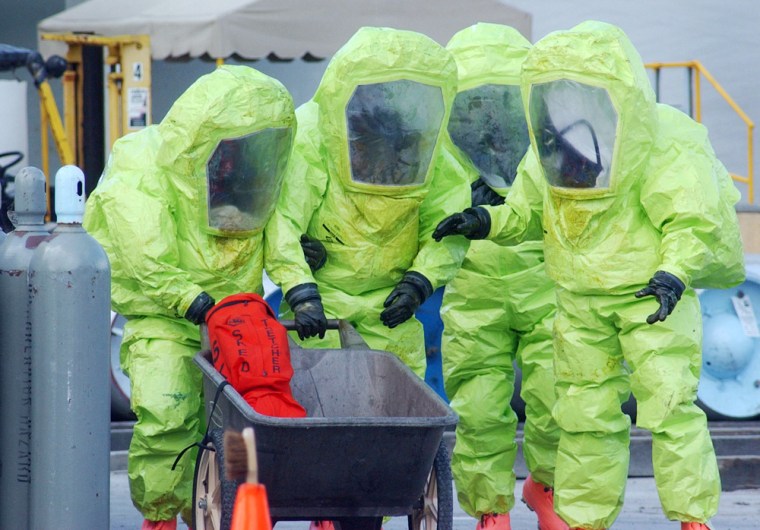Experts call it one of the worst-case scenarios in a terrorist attack: a cloud of lung-melting gas or a toxic fireball ripping though a U.S. city. Potential casualties: 1 million or more.
At least 100 chemical plants nationwide could be targeted to produce such devastation, according to congressional researchers in a report that was to be released Wednesday.
The tally of plants possessing large amounts of 140 toxic and flammable chemicals was compiled by the Congressional Research Service using Environmental Protection Agency data from May, the most recent available. It represents one of the first public state-by-state breakdowns of how close potentially deadly facilities are located to the nation’s largest population centers.
“Chemical facilities are at the top of the terrorists’ target list, and I thought it would be helpful for the full picture to be presented,” Rep. Edward J. Markey, D-Mass., said in an interview Tuesday.
The survey provided state-by-state figures but did not specify the names of the facilities or the cities in which they are located. However, researchers called it “unlikely” that the entire population would be affected by a single chemical release.
2003 database names names
A 2003 database compiled by environmental watchdog groups said chemical facilities near major American population centers include the AMVAC America plant in Los Angeles, the Infineum USA Bayway Chemical Plant in northern New Jersey, and six plants that store chlorine and sulfur dioxide in Houston.

The EPA refuses to release its own list of detailed locations of the chemical manufacturing plants, oil refineries and storage facilities for fear doing so could aid terror plans. Environmental watchdog groups have compiled incomplete or outdated tallies of chemical facilities.
“Nobody wants us handing out information that people with nefarious things on their minds would use to their advantage,” said EPA spokesman Dale Kemery.
The report also tallied the numbers of chemical plants in smaller and rural areas. About one-fifth of the nation’s chemical facilities — which exceed 10,000 — are close to population centers.
Experts said the number of injuries or deaths caused by emissions of chemical explosives or toxic gases would depend largely on unpredictable factors like wind current or the extent of the leak. But they agreed the report highlights the continued danger of questionable security practices at plants.
If released, the toxic chemicals can “cause poison gas clouds to kill people,” said Andy Igrejas, a chemical industry watchdog at the National Environmental Trust. “It’s violent deaths you’re talking about — it melts your lungs, essentially.”
The report, completed at Markey’s request, comes as the Homeland Security Department considers tougher federal regulation of the chemical industry, which has largely policed its own security procedures.
Last month, Homeland Security Acting Undersecretary Robert Stephan told congressional committees that “it has become clear that the entirely voluntary efforts of these companies alone will not sufficiently address security for the entire sector.”
Agency's worst-case: Under 10,000 killed
Stephan also estimated that fewer than 10,000 people would be killed and 40,000 sickened in a worst-case chemical release. Homeland Security officials have said only a small number of facilities — perhaps as few as a handful — have the capacity to cause widespread damage.
Several industry representatives contacted Tuesday declined immediate comment.
The report estimates at least 106 and as many as 111 plants are located near population centers of 1 million people or more. Congressional researchers could not provide a single number of facilities in question because they said they lack updated information in some cases, such as the types and volumes of chemicals produced.
Up to 29 of the plants were located in Texas — more than twice as many than in any other state. Illinois and California each had up to 13 such plants, Ohio had eight, and Florida and New Jersey had seven apiece.
Market cites administration
Kemery, the EPA spokesman, and environmental experts agreed that the overall estimate represents a drop from 123 plants five years ago — partially because of industry efforts to use alternatives to the deadly chemicals or to move away from densely populated areas.
But Markey said the industry still has not gone far enough to seek safer alternatives, test its security measures and protect employee whistleblowers. Nor has the Bush administration pushed hard enough to demand those precautions, he said.
The administration “still has refused to put its money where its mouth is and commit to any meaningful upgrades,” Markey said.
